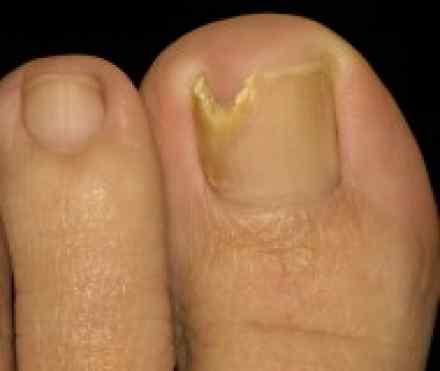
What is it?
An infection of nail fungus occurs when fungi infect one or more of your nails. A nail fungal infection may begin as a white or yellow spot under the tip of your fingernail or toenail. As the nail fungus spreads deeper into your nail, it may cause your nail to discolour, thicken and develop crumbling edges — an unsightly and potentially painful problem.
An infection with nail fungus may be difficult to treat, and infections may recur. But medications are available to help clear up nail fungus.
Symptoms
You may have a nail fungal infection — also called onychomycosis— if one or more of your nails are:
- Thickened
- Brittle, crumbly or ragged
- Distorted in shape
- Dull, with no luster or shine
- A dark color, caused by debris building up under your nail
Infected nails also may separate from the nail bed, a condition called onycholysis. You may feel pain in your toes or fingertips and detect a slightly foul odour.
Causes
Fungi are microscopic organisms that don't need sunlight to survive. Some fungi have beneficial uses, while others cause illness and infection.
Nail fungal infections are typically caused by a fungus that belongs to a group of fungi called dermatophytes. But yeasts and moulds also can be responsible for nail fungal infections.
All of these microscopic organisms live in warm, moist environments, including swimming pools and showers. They can invade your skin through tiny invisible cuts or through a small separation between your nail and nail bed. They cause problems only if your nails are continually exposed to warmth and moisture — conditions perfect for the growth and spread of fungi.
Infection with nail fungus occurs more in toenails than in fingernails because toenails are often confined in a dark, warm, moist environment inside your shoes — where fungi can thrive. Another reason may be the diminished blood circulation to the toes as compared with the fingers, which makes it harder for your body's immune system to detect and eliminate the infection.
Risk factors
Nail fungus is more common among older adults for several reasons, including diminished blood circulation and more years of exposure to fungi. Also, nails may grow more slowly and thicken with age, making them more susceptible to infection. Nail fungus tends to affect men more often than it does women, particularly those with a family history of this infection.
Other factors that can increase your risk of developing nail fungus include:
- Perspiring heavily
- Working in a humid or moist environment
- Having the skin condition psoriasis
- Wearing socks and shoes that hinder ventilation and don't absorb perspiration
- Walking barefoot in damp public places, such as swimming pools, gyms and shower rooms
- Having athlete's foot (tinea pedis)
- Having a minor skin or nail injury, a damaged nail or another infection
- Having diabetes, circulation problems or a weakened immune system
Complications
Nail fungal infections can be painful and may cause permanent damage to your nails. They may also lead to other serious infections that can spread beyond your feet if you have a suppressed immune system due to medication, diabetes or other conditions.
Fungal infections of the nail pose the most serious health risk for people with diabetes and for those with weakened immune systems, such as people with leukemia, AIDS or those who've had an organ transplant. If you have diabetes, your blood circulation and the nerve supply to your feet can become impaired. You're also at greater risk for cellulitis, a potentially serious bacterial skin infection. Therefore, any relatively minor injury to your feet — including a nail fungal infection — can lead to a more serious complication, requiring timely medical care. See your doctor immediately if you suspect nail fungus.
Diagnosis
Your doctor will likely examine your nails first. To test for fungi, your doctor may scrape some debris from under your nail for analysis.
The debris can be examined under a microscope or cultured in a lab to identify what's causing the infection. Other conditions, such as psoriasis, can mimic a fungal infection of the nail. Microorganisms, including yeast and bacteria, also can infect nails. Knowing the cause of your infection helps determine the best course of treatment.
References
http://www.nhs.uk/conditions/Fungal-nail-infection/Pages/Introduction.aspx
https://www.hse.ie/eng/health/az/F/Fungal-nail-infection/Treating-fungal-nail-infection.html
http://www.mayoclinic.org/diseases-conditions/nail-fungus/basics/treatment/con-20019319
http://www.webmd.com/skin-problems-and-treatments/tc/fungal-nail-infections-treatment-overview

